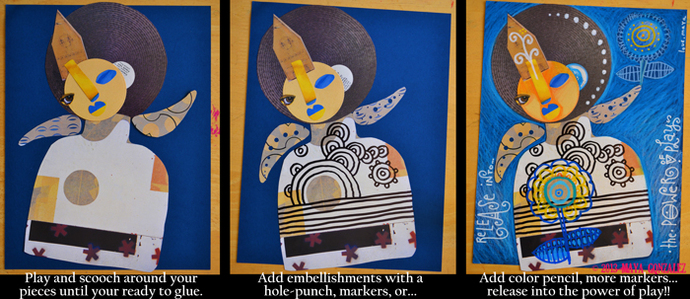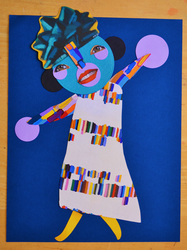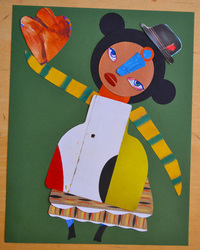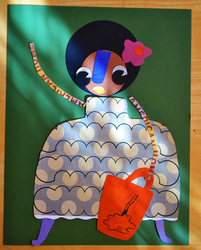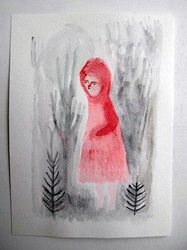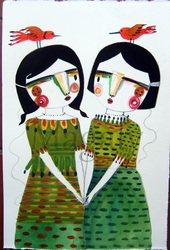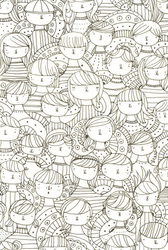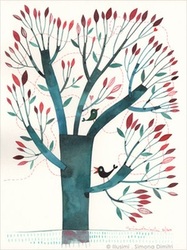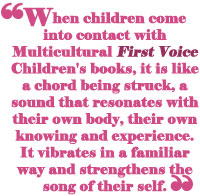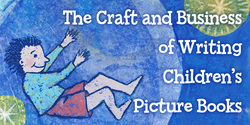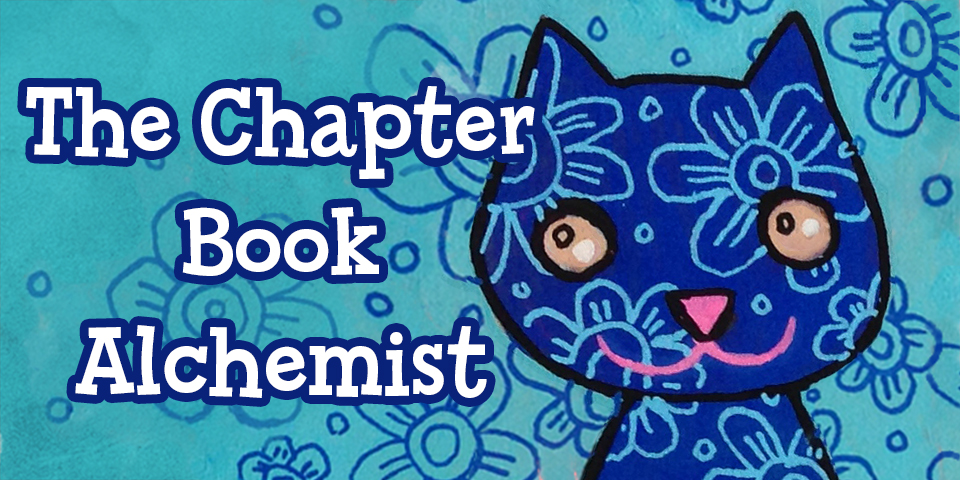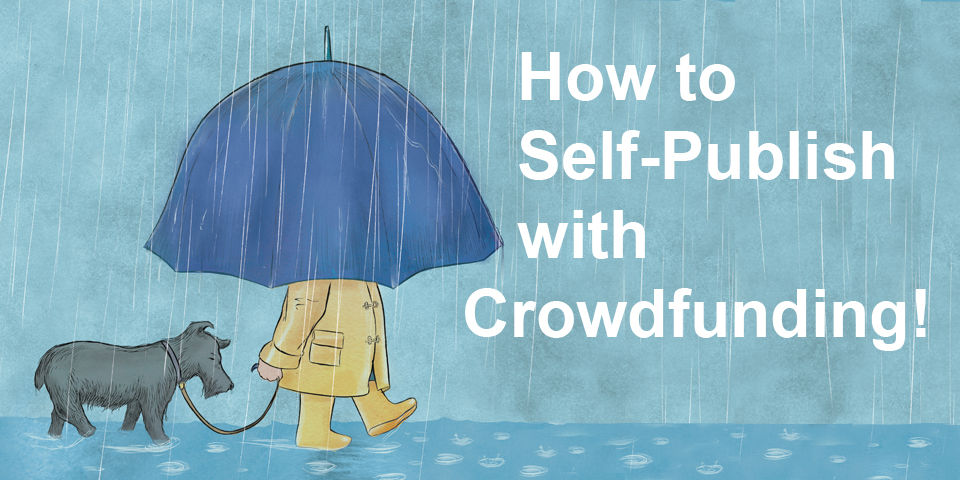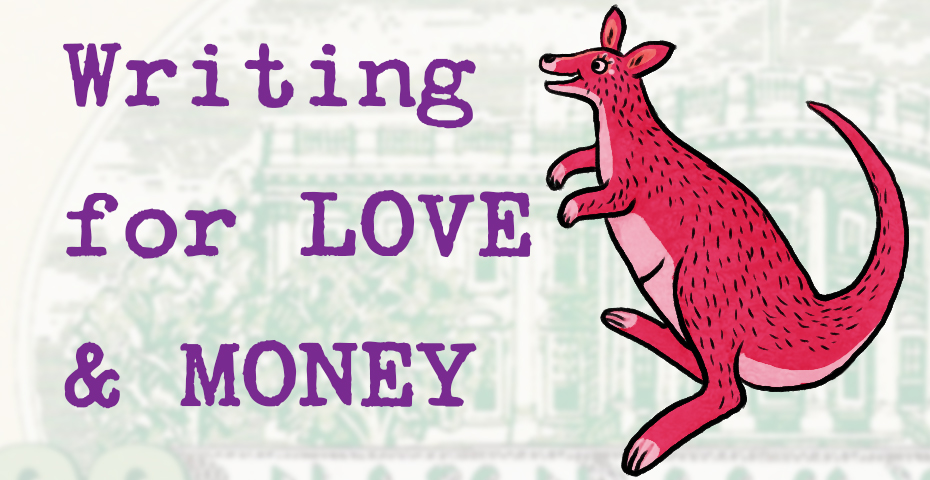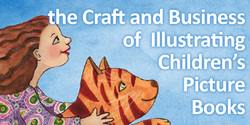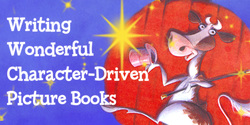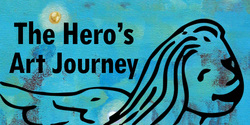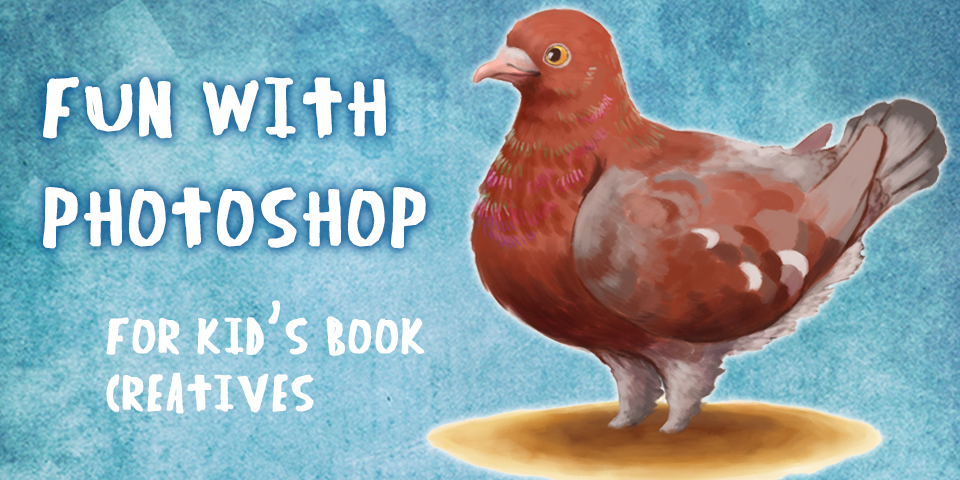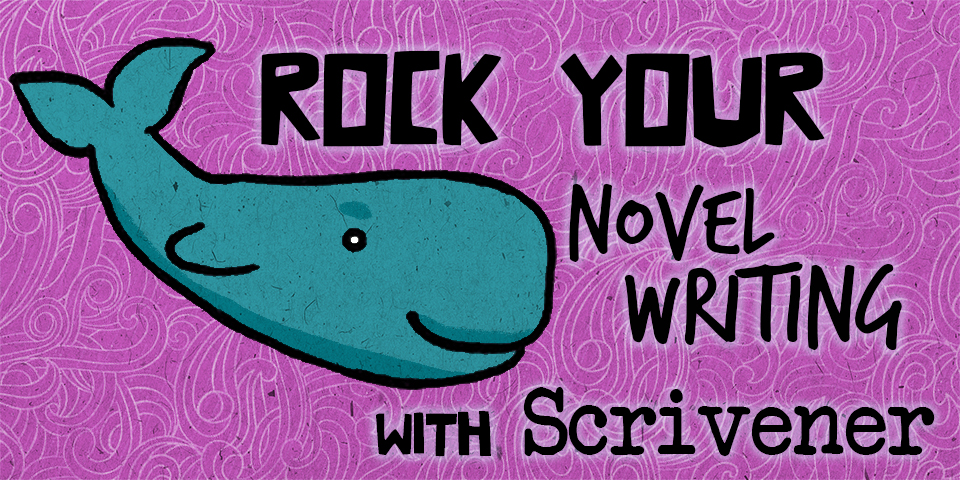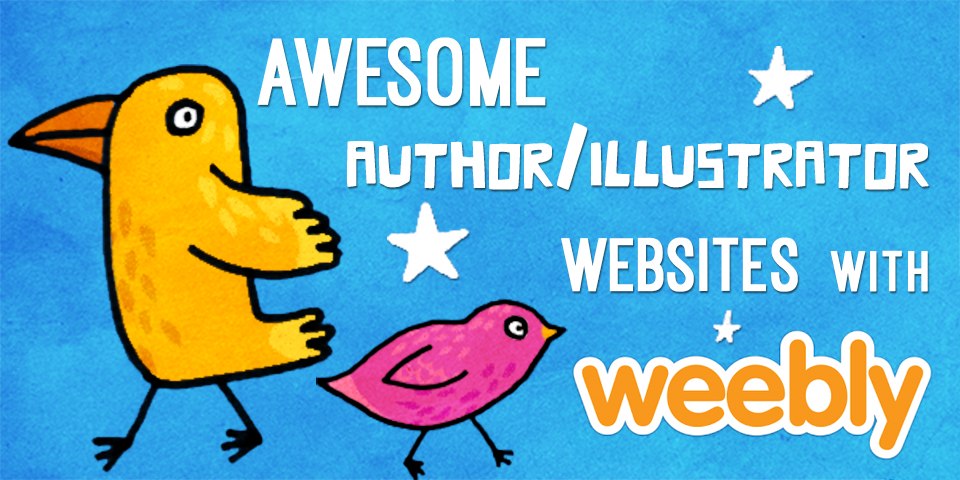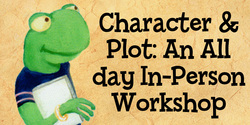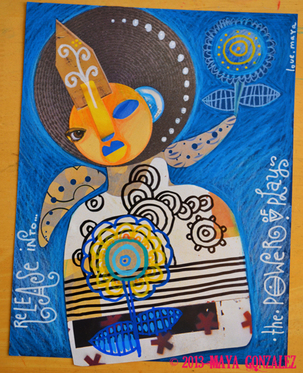 Release into the Power of Play... Last month I encouraged you to:
Ok, so this month, we’re returning to the glory of cutting and pasting. I forever find myself returning to this brilliant game. And once I begin it’s so hard for me to stop. Just playing for a long moment for this demo had me all charged up and dying to investigate further. Paper and pencils, glue and scissors-freedom at my fingertips! Something happens when we play. Just like when we were children, when we play, we learn. Returning to the tools of childhood provide us with a familiar door back to the creative wisdom we were born with. 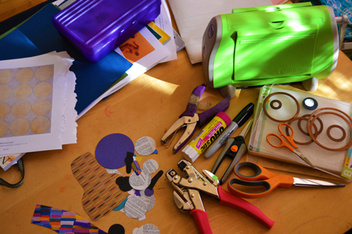 Gather Your Materials Gather Your Materials This project is a great way to begin playing with the empty page. Cut out a bunch of elements and then play puzzle with them. See how things look this way and that. Experiment with layering a figure into place. You don’t have to have the whole body figured out. You could have legs and arms, and a head and a body and move them around or cut more pieces until everything feels just right to you. Create characters, explore background, experiment with style, show movement. The sky’s the limit! You can see, I like big hair and big dresses! I have since I was a wee nibble. So you too get to do whatever YOU LIKE! Maybe it’s the thing you always drew when you were a kid, like mine is. 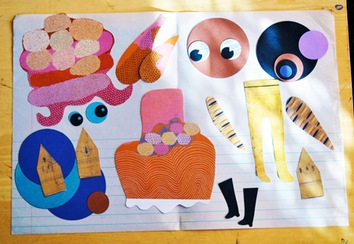 Cut out shapes and patterns from anything that strikes you Cut out shapes and patterns from anything that strikes you I got a little fancy with the cutting part. I whipped out my trusty die cut contraption. I have a Cuttlebug, which I love (It's that green thing in the picture above). I love the circle dies. I have hearts and scalloped ovals, but there’s something about the circles. They’re so round :-). Only recently have I found out about the tools that exist because of the new craft genre of “scrapbooking.” I love discovering this whole new world where “scrapbook” is turned into a verb and through the transformation is elevated to crazy heights of fabulousness. A far cry from my old photos in cellophane pages in a cardboard binder. I warmed up for this project by cutting circles in colored paper. This got my imagination stirring. I had an old art journal and the ever collage-ready National Geographic, which I barely used. I went through each page, ripping out whatever caught my eye. The art journal turned out to be the best because it had all this patterned stuff, (which reminded me of the great paper you can get for scrapbooking.) I cut arm-ish looking limbs and boots and dresses and a wig or two. I cut more than I needed. I cut until I felt done cutting. I laid all the elements out on a piece of paper and scooched them around until something fell into place. Sometimes I had to cut something else out. Then I glued everything down. I used color pencils, a permanent black marker and a white acrylic pen over everything and I decorated the sleeves by putting holes in them with my multiple size hole punchers! On the one I above that I fully finished, the face is construction paper and the ear is cut from the page of a dictionary. I had so much fun. I loosened up and relaxed. I played. It was awesome. In fact I had so much fun, I’m thinking I want to illustrate a book using this style now. My mind is exploding with ideas. Join me? Got paper, glue and scissors? Then freedom is yours! You are an artist. I know. P.S. Did you gather images last month? Did you scribble? Both of those things will come in handy with this project!!! And let me know how it goes! Here's some more samples from my playing...(click images to enlarge) Maya Gonzalez is largely self-taught. She has illustrated over 20 award-winning multicultural children’s books and written 3 with, not an end in sight! Her latest book, Call Me Tree, set to come out next year with Lee&Low Books, is her most recent labor of love! Her fine art has shown internationally and appears in numerous books about the contemporary Chicano Art Movement including on the cover of Living Chicana Theory and Contemporary Chicana and Chicano Art: Artists, Works, Culture and Education considered to be "the Bible of Chicano/a art." Ridiculously creative, she’s probably making art as you read this or thinking about making art if she’s driving a car or using the stove. And one of her ultimate passions is inspiring others to create books, because she believes that creating children's books has the potential to be one of the most radical things you can do!
1 Comment
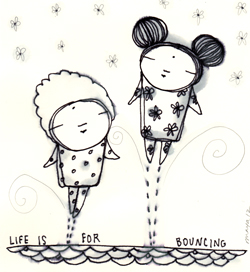 Artwork by Maya Gonzalez Artwork by Maya Gonzalez Hands down the most important thing I have ever learned to keep creativity flowing is to do just that, go with the flow. Last month the computer crashed, the blog seemed lost and all I could do was my best to stay buoyant and trust. And here we are! Flowed all the way into the next month! The computer lives! And here is the post I thought had vanished deep behind the blue screen of death last month. Viva creativity! Viva the flow! I realized recently this would be the perfect space to begin a short series of guidance toward illustrating your own children’s book manuscript. The other day I was chatting with someone professionally and they said I was a “rare breed” to be both an artist and an author of children’s books. Interesting, I thought, since my first rule of art is EVERYONE IS AN ARTIST. So I’m out to spread the word! I’m no rare breed. YOU too can illustrate the tale you’ve told! You don’t have to think of yourself as an artist to do it. You already are an artist. You’re a story teller. You’ll just be adding another dimension to your telling. Authorartists! A NEW breed! Rare at first perhaps, but growing! I won’t go into all the details or the this and that’s of illustrating. No, no, no. To begin, just let your imagination run free. Take it slow. Take a nice long moment to be FREEE. Let yourself just look, look, look around to see what kinds of illustrations you like and might even feel like you could do! Look everywhere, not just at children’s books. Look at magazines and CD covers, advertisements and movie posters, fine art, even recipe books, fabric patterns, food labels! Look at everything. 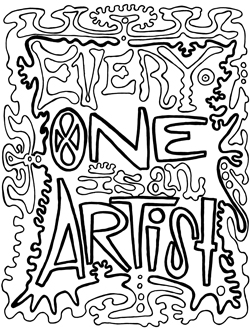 Click to download your copy to color! Click to download your copy to color! Look for things that look fun and easy to do, like cut paper, collage, photography and simple drawing and painting. Be a kid again. Remember what it’s like to feel that you can do anything in the world. Pretend and play. Download my Everyone is an Artist handout to color. Mess around drawing figures and funny faces. Get a new pencil or some charcoal and scribble and smear. Don’t be precise. In fact, be imprecise--please! I LOVE images that feel raw and immediate and I love children’s books with art a kid could figure out and imitate. Gather a nice cache of images to start. I’ve included some of the images at the bottom of this post that I’ve gathered lately. You will begin to see what you like. Don’t try to figure out how it’s done just yet. Know that you are an artist and soon you will be making more and more art. Next month we’ll take it a step further. Did you know relaxation and a sense of play allow the flow to flow more flowingly? So to recap, your job this next month is to:
Come be part of a new breed of authorartists! This month I’ll also be joining Mira in her Hero’s Art Journey interactive e-course, a great place to gather lots of images from art history, journey through your blocks and fears about creativity, learn gobs of techniques and begin to make art in community! And of course, play! And, here's some imagery that I've been drawn to lately: (click images to view the gallery) Maya Gonzalez is largely self-taught. She has illustrated over 20 award-winning multicultural children’s books and written 3 with, not an end in sight! Her latest book, Call Me Tree, set to come out next year with Lee&Low Books, is her most recent labor of love! Her fine art has shown internationally and appears in numerous books about the contemporary Chicano Art Movement including on the cover of Living Chicana Theory and Contemporary Chicana and Chicano Art: Artists, Works, Culture and Education considered to be "the Bible of Chicano/a art." Ridiculously creative, she’s probably making art as you read this or thinking about making art if she’s driving a car or using the stove. And one of her ultimate passions is inspiring others to create books, because she believes that creating children's books has the potential to be one of the most radical things you can do! Perhaps you've been there. Written or created something wonderful on your computer and then your computer crashes and your work is lost either completely or for a long moment. That was my experience this week with my blog post. All set to post and then the "blue screen of death" appeared and the post, along with several other business files, now hibernates in computer space or perhaps gone forever...I'll find out on Monday. It's times like these when we are really stretched to surrender and let go into the creative flow because there's really no other choice. Always something to learn in these moments. Is it a powerful redirect, or is it something to test your resolve, or is it simply a practice in embracing the unknown as I talked about last month. Whatever the lesson, it is a powerful reminder to go with the creative flow of life and art. But since my post isn't happening as planned, I thought I'd offer a video from my online class that just started, Painting and Photo Collage, as a substitute. My original post was going to explore how anyone can illustrate their own work and begin to look at different techniques to make this happen, so in a way this video is a nice supplement. In this video I discuss the visual understory and symbolism that lends depth and meaning to the book I illustrated, Nana's Big Surprise, by Amada Irma Perez. I also begin to look at how the artwork was constructed. Enjoy the video and here's to going with the flow! Maya Gonzalez is largely self-taught. She has illustrated over 20 award-winning multicultural children’s books and written 3 with, not an end in sight! Her latest book, Call Me Tree, set to come out next year with Lee&Low Books, is her most recent labor of love! Her fine art has shown internationally and appears in numerous books about the contemporary Chicano Art Movement including on the cover of Living Chicana Theory and Contemporary Chicana and Chicano Art: Artists, Works, Culture and Education considered to be "the Bible of Chicano/a art." Ridiculously creative, she’s probably making art as you read this or thinking about making art if she’s driving a car or using the stove. And one of her ultimate passions is inspiring others to create books, because she believes that creating children's books has the potential to be one of the most radical things you can do! 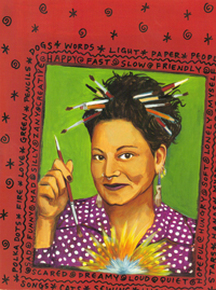 I am about to embark on another illustrating adventure. Right now the art director is being set up. Text is being finalized. I’ll be doing sketches soon, based on the thumbnails and roughs I have already sent the publisher. It won’t be long before I’ll be painting. That’s funny. I just got a chill up my back and an old familiar feeling in my chest. It is an adventure. I am in it now. I can feel it. Creating a book is always a journey. Always something learned. Always an understory that layers into the art. This next book, which I wrote and will illustrate is LOADED with personal understory already. I can only imagine what all will have occurred by the time I have it in my hands in its final form. When I look back at all my books I can recall how I felt while I was creating each of them, what was going on in my life at the time. I can see how the art reflects that, whether I intended it to or not. I can see what was important to me and what compelled me. What I notice the most is how I illustrated many books based on what I needed in the classroom to teach art. Hilariously, in those days, I saw completed books more as tools, than as things unto themselves. I was focused on creating book art that kids could look at up close and figure out how to do, either with my help when visiting them, or on their own, like I would have done as a kid. I wanted to create techniques that were accessible, fun and familiar that a kid could successfully do and feel good about. Attending to book art in this way was F*U*N! I learned TONS and played like a maniac. I would just come up with a concept and decide that was it! Sometimes I was quite stretched to learn things fast enough to keep up with my own vision, but it kept me on my feet and always reminded me of how kids feel all the time—always in the unknown, always on an adventure learning fast as you gogogo. And now I know tons of cool, weird techniques that I just made up. 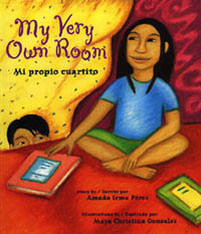 One of the first books I did like this was My Very Own Room by Amada Irma Perez. I LOVE introducing kids to oil pastels in the classroom, so of course, I had to do a book with them. But MY MY it was tricky business and fabulously messy! All the more reason to do it I guess! I still love the look of the rich textures and the originals I have continue to look fresh. Shipping them and storing them is delicate business however. But I highly recommend playing with them for illustrating. It was a good adventure. EVERYONE should play with oil pastels! If you’re getting dirty you know you’re making art I always say. Then there were things I heard in the classroom, conversations about someone “cheating” when making art. I was intrigued by this whole cheating concept and how incensed the kids would get about it. So I decided that I would try to cheat as much as possible in a book. 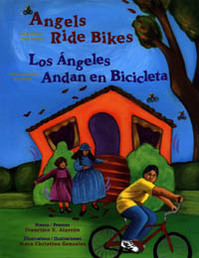 In Angel’s Ride Bikes and Other Fall Poems by Francisco Alarcon I decided that I would take photographs of all the humans and put those into my spreads instead of drawing them myself and only draw the environments around them. Then I painted across the whole spread. I even made a point of leaving visible paper edges where I glued the copied photos onto the larger paper so I could point out and say to kids, see here is where I glued it down. I have had some great conversations about cheating when I share this book. And I have watched a lot of kids feel easier about creating art when they know that even “an artist like me” makes art anyway she can and that’s a good thing. Art is art. No cheating possible. Making books with the classroom in mind has taught me well. Sometimes messy, sometimes deep. It’s good to know why we make books and that it is a journey, an adventure and many things big and small and mundane and profound are bound to be learned. I love the unknown. I love the surrender to a big, juicy project. I love the color and the smell of art materials and the prayers whispered between the layers to children I will never meet. Be strong. Belong. Be song. I love making books. We are a lucky crowd. Maya Gonzalez is largely self-taught. She has illustrated over 20 award-winning multicultural children’s books and written 3 with, not an end in sight! Her latest book, Call Me Tree, set to come out next year with Lee&Low Books, is her most recent labor of love! Her fine art has shown internationally and appears in numerous books about the contemporary Chicano Art Movement including on the cover of Living Chicana Theory and Contemporary Chicana and Chicano Art: Artists, Works, Culture and Education considered to be "the Bible of Chicano/a art." Ridiculously creative, she’s probably making art as you read this or thinking about making art if she’s driving a car or using the stove. And one of her ultimate passions is inspiring others to create books, because she believes that creating children's books has the potential to be one of the most radical things you can do! 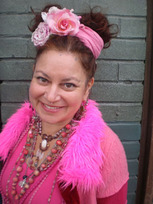 What do polka dots and self-portraits have to do with First Voice multicultural children's books? Let's take a walk together and see... Everyone is an artist. This is the first "rule" of my Claiming Face curriculum that i teach when I go into schools to share about being a children's book artist and author. We know that everyone is unique. It goes without saying. But did you know that this includes how we mark the page? I call it the Polka Dot Theory. I have noticed over the years that even if someone is only making a polka dot, it is visibly theirs and no one else’s. How we hold a pencil is uniquely our own. No one can make a polka dot the same way. Somehow, some way our body, our stories, our thoughts, our selves make a basic mark that is uniquely our own, however subtle, however small, this mark shows something about us. To me, this is the beginning of art. This is the beginning of expressing something that is ours and ours alone. 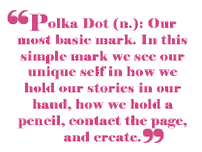 The power of the polka dot is amplified when we go beyond that initial mark and express ourselves more fully, through self-portraiture or words. I like beginning with acknowledging the polka dot, because it hints at the vast and multidimensional levels available to us when we engage in creation/expression. This includes not only our own exceedingly unique and individual experience, but also all of our cultural, social and historical influences as well. 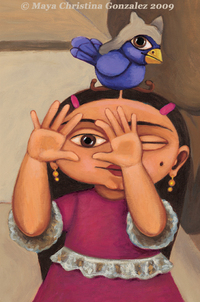 My hands, my polka dot, my art, my words convey my life as Maya, but also my life as a bi-racial, Chicana, working class, queer person born with a girl body. The colors that speak to me, the way I layer and collage, the images that are familiar and make up a cohesive visual vocabulary for me are telling. Growing up with half of my family speaking Spanish while I did not, the inflection, song, tone, the way of putting words together, the white teachers who spoke at the front of my class, the children of color and the way we whispered in the back of class, all of this informed how I write and what I write. My father taught me through actions, through beliefs, through our shared culture, the importance of the wind, the sound of birds, the tale a tree tells as it grows, the dance between life and death, the spirit within all things. This is in my hands, my eyes, my heart when I take up a pencil or a paint brush. I am what and how I express. What's fascinating is that some of it can be tracked, while some of it cannot. It is the deep, abiding legacy of generations and generations of Mexicans and Germans. It goes beyond color and image relevance and hints at something at once mysterious and completely true. When I began making art for children's books it was for amazing authors like Gloria Anzuldúa, Francisco Alarcón and Amada Irma Peréz whose stories felt familiar either to me, or relevant to my community. They included stories about immigration, curanderas, Mexico, tamales, piñatas, familia, Los Angeles, and more. These First Voice books focused on specific Latino/Chicano experiences. But it is not a requirement that First Voice books solely focus on things specific only to our communities and culture. The two children's books I have written and made art for are also First Voice books. I write about my relationship with nature and the world around me. My experience of these things cannot be separated from who I am and the influence my history and culture has upon them. My Colors, My World/Mis Colores, Mi Mundo and I Know the River Loves Me/Yo Sé Que El Río Me Ama are equally First Voice books. Growing up as I did informed what and how I both wrote and made art for these stories. Beyond fiestas and chili peppers, it is important for children to also see a young Chicana girl share her experience of her world in the way only she can. This communicates volumes about our Chicana/Latina experience and sensibility.
Each time I sensed a lack of resonance, I looked more closely at the author and artist and each time I found that they did not originate from the community they were representing. It is not that their books lacked merit, by no means. But it did feel different. And each time, I got this funny feeling in my gut, it reminded me of educators, professors, experts, ethnographers, authors and artists who were telling me about me or my people or my culture. I did not feel felt. I felt studied, categorized, defined and documented by outsiders. I did not feel that I belonged. I felt separate. 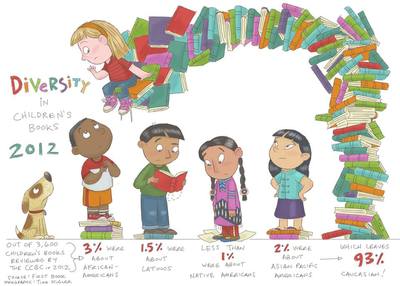 graphic created by Tina Kugler graphic created by Tina Kugler This is what First Voice Multicultural children's books give to our children. It is not just familiar or relevant imagery or story, it is much deeper than that. It is something at once substantial and very humanly ethereal. It is an osmotic communication of self-knowledge, self-definition, a celebration of belonging to yourself and to the individual culture that informs who you are. This is important for all of us, ALL of us, but especially for our children and extra especially for our children of color. We need to sense that we all belong here, now. This makes all of us strong. And for children of color, this inspires us to contribute to our society and our world, because it is ours, it is where we belong. I speak to First Voice Multicultural books for children of color because of the statistics. While 2012 statistics show that almost 50% of our children under age 5 are children of color, less than 10% of children’s books published each year are about children of color and the statistics are even lower (with only 4½ % of the 5000 children's books published in 2012) when it comes to First Voice children’s books, those books that are both about AND by people of color. For our published children's books to be reflective of the reality of the children in our country, our schools, our libraries, our communities, we would need to replace 2000 of those 5000 books with First Voice Multicultural books. 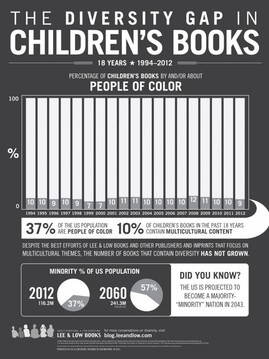 graphic created by Lee&Low Books graphic created by Lee&Low Books Wow, every time I do the math for these kind of statistics, I have to double check myself because I am stunned. The math makes our lack of reflection so conspicuous. I know that I felt this growing up. And I know that our children today feel it. Amazingly, the last 18 years show an absolute freeze when it comes to multicultural children’s books that are published. I was undaunted as a child. Now as an adult, I teach what helped me through the long-lived scarce times: I teach self-portraiture. Just because we do not see ourselves in our books, we must still see ourselves. We must know our selves, feel that belonging by our own hands if not by the hands of the world around us. Until we have those 2000 more First Voice Multicultural children's books per year, we can empower our children to claim their own face, tell their own tales, so that when they grow up, they are prepared to balance the way things are. Today. Now. We begin with a polka dot. Maya Gonzalez is largely self-taught. She has illustrated over 20 award-winning multicultural children’s books and written 3 with, not an end in sight! Her fine art has shown internationally and appears in numerous books about the contemporary Chicano Art Movement including on the cover of Living Chicana Theory and Contemporary Chicana and Chicano Art: Artists, Works, Culture and Education considered to be "the Bible of Chicano/a art." Ridiculously creative, she’s probably making art as you read this or thinking about making art if she’s driving a car or using the stove. And one of her ultimate passions is inspiring others to create books, because she believes that creating children's books has the potential to be one of the most radical things you can do! |
Meet the Friday Blogonauts
First Fridays will feature Bryan Patrick Avery, published writer , man of mystery, and professional magician among other things.
Second Fridays will feature awesome multi-award winning author Marsha Diane Arnold who will be writing about character-driven and/or nature-based books and/or anything she likes :) Third Fridays will feature independent Aladdin/Simon & Shuster editor Emma Sector who has helped bring many books into the world. Fourth Fridays will feature the great Christine Taylor-Butler who has published over 70 award-winning fiction and non-fiction and nonfiction books including the acclaimed new middle grade series - The Lost Tribes. Fifth Fridays will feature the fabulous Carl Angel award-winning multi-published Illustrator and graphic designer. Join our Tribe
and receive 7 Steps to Creative Happiness, access to free webinars, and lots more!
Your email addresses are always safe and respected with us. Follow our Blog!
Archives
January 2019
Categories
All
|
|
Discover
|
About Us
|
Join Us
Join our Community and receive a fabulous free gift, KidLit tips, newsletters, scholarship info, contests, and more!
Join our KidLit Mentorship |
Social Media
Interact with our FaceBook Group or follow us on:
|
© 2010-2024 All content on this website is copyrighted. Sorry, all courses are non-refundable.
